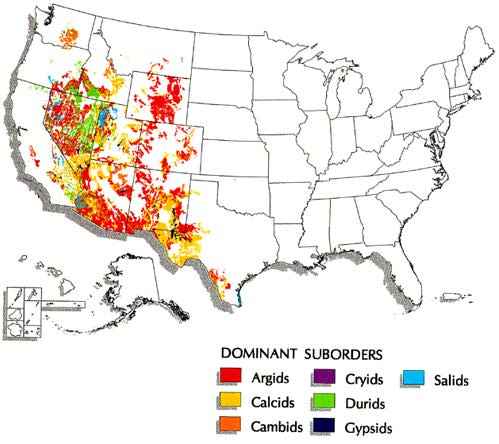Aridisols
Aridisols, (known as "dry soils") are the most widely distributed of the twelve soil orders defined by the United States Department of Agriculture (USDA), occupying about 19% of Earth’s terrestrial surface [2]. Aridisols are present in arid and semi-arid regions around the world, comprising large areas of five different continents. Specific countries and regions where aridisols are prevalent include the western United States, Argentina, Namibia, South Africa, areas of North Africa and the Horn of Africa, the Middle East, Kazakhstan, China, Mongolia, and Australia [2].
Map of aridisol suborder distribution in the United States [9]
Description
Aridisols are found in arid and semiarid climates, and thus are characterized by an aridic soil moisture regime and somewhat weak profile development (see: Soil Horizons), often consisting of sandy, gravelly loams [1]. The lack of soil moisture distinguishes them from Inceptisols and Entisols, which are also characterized by weak profile development. Aridisols also differ due to having an ochric epipedon, and any of either a cambic horizon, argillic horizon, and/or salic horizon [6]. The ochric epipedon extends from the A to the upper B horizon, and is light-colored due to the lack of organic matter present in aridisols [1]. The argillic horizon forms via subsurface accumulation of silicate clays, and the salic horizon is formed from the accumulation of salts [1]. Calcium carbonate often accumulates in the B and C horizons, in a process called calcification [6].

The threshold for soil moisture content in aridisols is that sufficient moisture for plant growth is never sustained for 90 consecutive days [6]. The dryness of aridisols and lack of vegetation cover means that these soils are very susceptible to soil erosion by wind and by water. This is often exacerbated by land uses such as livestock grazing and construction, which loosen topsoil and remove sources of shear strength, primarily desert brush.
Ecology
In areas of North America where aridisols dominate, such as the Chihuahuan Desert, common vegetation includes creosote (Larrea tridentata), mesquite (genus Prosopis), ragweed (genus Ambrosia), cacti, and various other species of desert shrubs and grasses [5]. Vegetation communities typically occur in patchy formations as a result of overland flow, which is the dominant hillslope process for precipitation in arid and semiarid regions [5]. Each patch of vegetation intercepts runoff from overland flow, increasing infiltration and acting as a sink, while rills and interrills form downslope [5]. Detritus composition occurs primarily from two mechanisms – abiotic weathering, and consumption by termites [8]. Abiotic weathering includes the intense drying out caused by ultraviolet radiation, and the physical impact of infrequent but sometimes heavy rainfall (similar to splash erosion of soil), on aridisol surface litter. While many different species of soil micro- and meso-fauna exist in aridisol ecosystems, their density is generally too low to impact decomposition rates [8].

Since net primary productivity in aridisol ecosystems is generally much lower than in wetter climates, certain soil biota (particularly termites) are of much importance for increasing the availability of nitrogen. Termites are considered a keystone species in the Chihuahuan Desert because of their efficient consumption of detritus (see: Detritusphere) and fixation of nitrogen (see: Nitrogen cycle) [10]. Multiple studies from the Chihuahuan Desert have found that termites are responsible for over 50% of mass losses of decaying surface litter, sometimes much greater [7]. One study indicated that creosotebush wood could take 100 years to fully decompose (see: Decomposition) without the presence of termites [11]. Additionally, termite feces are a significant source of nitrogen for desert soil ecosystems, which can have cascading benefits for fungal communities and the associated ecosystem services that they provide for vegetation and soil fauna [11].
Other aridisol soil fauna of note include Darkling Beetles (Tenebrionidae), which actively consume surface litter, and scorpions (order Scorpiones), which are often a dominant predator in arid and semiarid soil ecosystems [3,5].
Land Use
In arid and semiarid regions, livestock grazing is a major land use. Irrigation is typically required due to limited water availability. Overgrazing by livestock can greatly alter aridisol ecosystems, as the distribution and composition of vegetation is directly affected by selection from the animals feeding on them [4]. Excessive trampling from livestock can also cause plant communities to diminish, which combined with overgrazing increases the susceptibility of aridisols to erosion by wind and water [4]. Managing the timing and intensity of grazing on pastures in dry climates involves conservation practices such as rotational grazing, which are critical to mitigate the risk of increased soil erosion in these areas.
References
[1]Brady, Nyle C., and Weil, Ray R. “Elements of the Nature and Properties of Soils.” 2000. Prentice Hall. Upper Saddle River, NJ.
[2]Christopherson, Robert W. “Geosystems: An Introduction to Physical Geography, Tenth Edition.” 2017. Pearson. Hoboken, NJ. pgs 538-539.
[3]Coleman, David C., Callaham Jr., Mac A., and Crossley Jr., D. A. “Fundamentals of Soil Ecology, Third Edition.” 2018. Academic Press. Cambridge, MA.
[4]Fesenmyer, K.A., Dauwalter, D.C., Evans, C., and Allai, T. Livestock Management, beaver, and climate influences on riparian vegetation in a semi-arid landscape. 2018. PLoS ONE. 13(12): e0208928.
[5] Polis, G.A. Complex trophic interactions in deserts: an empirical critique of food-web theory. 1991. Am. Nat. 138:123-155.
[6]Rossi, M.J. et al. Vegetation and terrain drivers of infiltration depth along a semiarid hillslope. 2018. Science of the Total Environment. 644:1399-1408.
[7] Silva, S.I., MacKay, W.P. and Whitford, W.G., 1985. The relative contributions of termites and microarthropods to fluffgrass litter disappearance in the Chihuahuan Desert. Oecologia. 67:31-34.
[8]Soil Taxonomy, Second Edition. 1999. United States Department of Agriculture Natural Resources Conservation Service. pgs 329-330.
[9]USDA Natural Resources Conservation Service. Aridisols Map. https://www.nrcs.usda.gov/wps/portal/nrcs/detail/soils/survey/class/maps/?cid=nrcs142p2_053595
[10]Whitford, W.G. Keystone arthropods as webmasters in desert ecosystems. 2000. In: Coleman, D.C., and Hendrix, P.F. (Eds.), Invertebrates as Webmasters in Ecosystems. CAB International, Wallingford, UK, pp. 25-41.
[11]Zak, J., and Whitford, W. Interactions among soil biota in desert ecosystems. 1988. Agriculture, Ecosystems, and Environment. 24:87-100.
